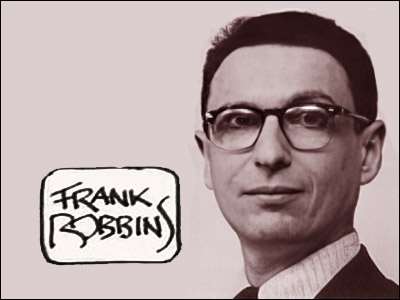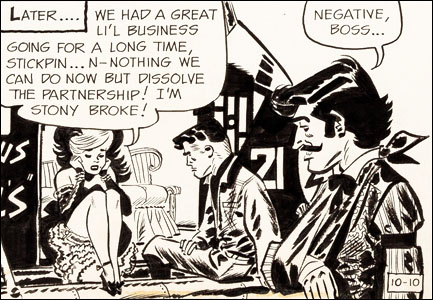
I spend less and less time these days reading online forums — on Facebook or elsewhere — about old comic books. It's a topic dear to my heart but discussions there are too often hijacked by the occasional participant who's lacking in knowledge about the field and/or an ability to cope with someone having different tastes. It's especially bad in debates over super-hero comics and especially especially (two especiallies) over super-hero comic book artists of the past.
The most debated-over of the seventies is probably Frank Robbins and after reading the eighty-seven quadrillionth thread about him, I feel the need to write something here about the man and his work…and by extension, about creative talents of his generation. In some cases, though the work is long since done and the folks who did it have passed from this mortal coil, some people are still hating on them…to what purpose, I have no idea.
I mean, it's not like there's a chance of Frank Robbins, who died in 1994, coming back and drawing more Captain America stories. Some of us loved what he did but there are folks who I think worry about that happening again. And he didn't even do that many.

Mr. Robbins was mainly a writer-artist for newspaper comic strips…and one of the best. Like about 50% of the artists who drew adventure newspaper strips at the time, he was heavily influenced by two men — Noel Sickles and Milton Caniff — who were in turn heavily-influenced by each other. Caniff in particular was regarded as the supreme role model by most in the adventure strip field and Robbins was hardly the only guy who drew a lot like him.
Robbins was such a natural at the Caniff/Sickles style that he not only got a job producing a nationally-syndicated strip at the age of 19 but the strip he was handed was the popular Scorchy Smith and he took it over from his hero, Noel Sickles. That's how good he was. At the age of 19.
A few years later, Robbins decided to create his own strip and his Johnny Hazard ran in papers from 1944 until 1977…a most impressive run. It was also in the Caniff/Sickles style but what a lot of his fellow artists believed but rarely spoke aloud was that Robbins "did" Caniff better than Caniff. Among his peers, that was a widely-held opinion — if not in the forties then certainly later on. The late Alex Toth used to rant on and on about how as Caniff's work declined over the years, Frank Robbins just got better and better.
Robbins was also, as an artist, lightning-fast. Caniff sometimes spent 60 hours a week producing the daily and Sunday Steve Canyon strip — and that was with one or more art assistants plus a letterer. Robbins, drawing a strip with similar density and detail, would write and draw Johnny Hazard in three days a week — two for the dailies, one for the Sunday page — unassisted except (sometimes) by a letterer. With the rest of his week, he would paint and do what some would call "fine art" and his creations wound up in some pretty prestigious galleries.

Robbins was proud of his "fine art" but there was a problem with it: It didn't pay all that well. And in the sixties, the kind of newspaper strip he drew was going out of fashion so his income from it was dropping slowly but certainly. He was concerned about that one evening around 1967 when at a gathering of the National Cartoonists Society, he met Carmine Infantino. Infantino was then transitioning from drawing for DC Comics to running DC Comics.
Infantino's mission right then was the reinvention/revitalization of the entire line and a lot of longtime freelancers were dismissed — some because they demanded health insurance, some because Carmine thought their work was old-fashioned and dull. There were also some personal animosities in play. One of the people he brought into the DC Talent Pool was Robbins, who decided that it would be more lucrative to spend the days he wasn't working on Johnny Hazard working for DC Comics.
He started as a writer and his first efforts were awful. There's a 1968 issue of The Flash where you can even find a letter from me saying as much. I am now embarrassed by some of those letters and I also now understand the problem that I didn't fully understand then. It wasn't all Mr. Robbins' fault. Marvel was gaining dangerously on DC in sales and several DC writers were ordered to emulate Stan Lee. They all did a pretty poor job of it, picking up on Stan's worst habits and missing even the point of them.
When Robbins stopped trying to do that, he turned out to be a pretty good writer. In fact, he became my favorite Batman writer of the period and I was pretty fussy about Batman writers. He also wrote Superboy for about four years producing what I think were the best Superboy stories ever done.
Eventually, Robbins also drew the occasional story for DC and on Batman, his artwork was instantly controversial…to say the least.